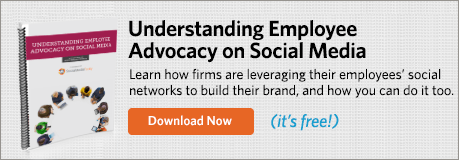Employee Advocacy in Social Media: Why Your Professional Services Firm Should Care

Professional services firms are buying in to the social media craze.
The idea of sharing content, updates, and press releases with an organically grown brand following will make marketing professionals light up like the Christmas tree at Rockefeller Plaza.
That is, until they realize their company-sponsored updates are falling on deaf ears. If this is the case with your firm, you may want to take a hard look at your social media marketing strategy.
Let’s cut to the chase. Your professional services brand won’t elicit the same type of engagement as established consumer brands. However, that does not mean that you should throw in the towel and abandon your social media strategy.
There are other ways to engage your audience, but first we must understand why social media is such a useful tool.
Long ago, people received information exclusively via word of mouth. In today’s digital age, communication is instant. Marketing experts have dubbed social media, “word of mouth on steroids,” and rightfully so. Information today spreads like wildfire.
So if social media is such a catalyst for communication, why aren’t you seeing the engagement from your firm created content? Enter employee advocacy.

What is employee advocacy?
In a nutshell, employee advocacy is the promotion of a firm’s brand by its employees.
But it goes much deeper than that. It’s a culture of believing and buying in to the content your firm produces, and seeking out opportunities to spark discussions on social networks with other individuals who share the same passion or interest.
SEE ALSO: Are Your Employees Advocates for Your Firm?
People are naturally social creatures, and are inclined to interact with other humans. This universal behavioral trait is why employee advocacy programs in the professional services world are successful. Since digital interaction is a removed form of communication, people are more likely to trust other people than a corporate voice.
There’s a calming effect when you know with whom you are talking to. Think back to Dorothy’s reaction when she discovered the great and powerful Oz was merely a man behind a curtain.
Just the ability to see a person’s name and picture on social media can go a long way in humanizing digital interaction.
What are the benefits of an employee advocacy program?
One of the biggest benefits firms are seeing in their employee advocacy programs is increased visibility on social networks. And with analytical tools at our disposal, visibility isn’t an abstract concept anymore.
It can be measured by a myriad of metrics including impressions, clicks, growth in social following, and many more. The list goes on.
The benefits of employee advocacy programs are not only limited to your firm. Employees that contribute to conversations are also building their personal brand and expanding their professional network by increasing their visible expertise.
This thought leadership reflects positively on both the firm brand and the employee, creating a two-way halo effect.
How engaged should employees really be?
With increased visibility comes increased engagement, but you still must target the right audience. Depending on the nature of your business, there are advantages and disadvantages for each social media platform. In the professional services world, LinkedIn is still king.
Using LinkedIn as an example, “discussions” started in groups relevant to the topic at hand can be a great opportunity for engaging with other professionals. Within these groups, LinkedIn gives preference to “discussions” with high levels of engagement, increasing their visibility in other people’s news feeds.
However, starting the discussion is only the first step. To really gain traction and see increased engagement around your firm’s content, you may need to contribute to other conversations too. Doing so will catch the eye of active members in groups and online communities, prompting further discussion.
Once recognized as a top contributor, visibility will increase, leading to a greater probability that other LinkedIn users will engage with your discussions and read your content.
How do I measure success in employee advocacy?
First of all, employee advocacy won’t work unless your employees buy in and take pride in the content that your firm produces. Establishing this culture doesn’t happen overnight, and assuming so can backfire.
That being said, there are some prerequisites that must be met before success can be measured:
- Firm produced content must be compelling, thought provoking, and relevant to your target audience.
- Management should communicate the benefits of employee advocacy, encourage employees to be active on social media, and set goals or expectations for employee engagement.
- Employees must know when, where, and how to share content and must also feel comfortable engaging in other conversations.
If these criteria are met, a successful employee advocacy program will yield positive, measurable results.
Firms that have implemented a formal employee advocacy program measure its success in a number of different ways:
- Increased web traffic
- Growth in the number of social followers
- Better search engine rankings
- Increased number of leads from social channels
Humanizing the digital experience opens doors to more organic forms of communication and is a good way to keep up with industry trends while building personal and firm brands simultaneously.
Additional Resources
- Download our latest free research report, Understanding Employee Advocacy on Social Media to see how the most successful firms are approaching employee advocacy.
- Our Social Media Guide for Professional Services is designed to give you everything you need to know to build a comprehensive social media strategy for your firm.
- And dive deeper into LinkedIn with our LinkedIn Guide for Professional Services Executives.
How Hinge Can Help
Social media marketing should be a core component of your firm's overall strategy. Hinge’s Visible Firm℠ is the leading marketing program for delivering greater visibility, growth, and profits. Based on 8 years of research into high-growth firms, this program gives firms like yours the practical tools and approach used by industry leaders.

Industries & Topics
Most Popular
- Business Development Strategy: A High-Growth Approach
- A 10 Step Brand Development Strategy for Your Professional Services Firm
- Strategic Marketing for Professional Services
- Digital Branding for Professional Services
- 10 Essential B2B Marketing Strategies to Grow Your Professional Services Firm
- Digital Marketing Strategy for Professional Services
- Rebranding Strategies: A Step-By-Step Approach for Professional Services
- Elements of a Successful Brand 1: Brand Positioning
- The Top 5 Business Challenges for Accounting & Financial Services Firms
- Find Your Differentiator: 21 Ways to Gain a Competitive Advantage for Your Firm
- Elements of a Successful Brand 4: Brand Promise
- What Is the Cost of Video Production for the Web?





Leave a Comment